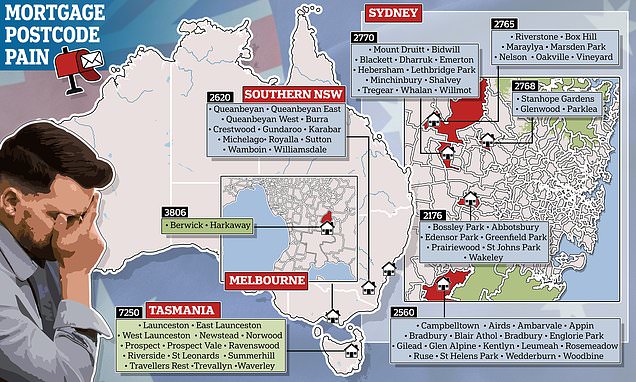
By Stephen Johnson, Economics Reporter For Daily Mail Australia
07:33 22 Apr 2023, updated 07:39 22 Apr 2023
- Mortgage stress at 100 per cent in some postcodes
- Sydney, Melbourne and regional areas are affected
Every borrower in parts of Sydney, Melbourne and some regional areas is now suffering from mortgage stress.
Digital Finance Analytics has mapped out the postcodes where 100 per cent of households are in a situation where their expenses exceed their income.
Mortgage stress occurs when someone can’t pay their bills because they don’t have the cash flow.
The most severe mortgage rate increases since 1989 are particularly hitting borrowers in the far outer suburbs of Australia’s biggest cities where pay rises are failing to keep pace with the soaring cost of living.
Campbelltown, 56km south-west of Sydney’s city centre, is struggling with 100 per cent of borrowers – or 12,198 households – in stress in the 2560 postcode, which also covers Airds, Leumeah and St Helens Park.
In Sydney’s west, mortgage stress is also universal in the 2770 postcode covering Mount Druitt, Bidwill, Minchinbury, Lethbridge Park and Whalan.
In Melbourne’s outer south-east, 100 per cent of borrowers – or 9,308 households – are stressed in the suburbs of Berwick and Harkaway.
Digital Finance Analytics principal Martin North said outer-suburban areas with high mortgage stress tended to have newer homes, which meant borrowers were less likely to have built up sufficient savings.
‘Many of these areas are those high-growth corridors where people have been buying off the plan,’ he said.
‘A lot of new building has been undertaken – a lot of people have big mortgages and, frankly, not much wriggle room.’
Launceston in northern Tasmania and Queanbeyan in southern NSW, bordering Canberra, also had a 100 per cent mortgage stress rate.
Across Australia, young, growing families were the most likely to be struggling with 86.23 per cent in mortgage stress, with the figure including many first-home buyers.
This was even higher than the 76.34 per cent average for battler suburbs.
Mr North said borrowers unable to refinance to a more competitive mortgage rate would be the worst off, especially if they only had a small home loan deposit.
‘We are seeing more people locked into what I’d call “mortgage prisons” simply because they’re not finding anybody who can give them a better rate because they have higher risks and limited equity in their property,’ he said.
Falling home prices also means these borrowers are more likely to be in negative equity where they owe the bank more than their home is worth.
The Reserve Bank of Australia’s 10 consecutive interest rate rises have already caused a 50 per cent surge in variable mortgage repayments, with the cash rate now at an 11-year high of 3.6 per cent.
The Commonwealth Bank and Westpac are both predicting the RBA will raise interest rates at least one time to 3.85 per cent in May.
ANZ is also predicting another 0.25 percentage point increase, taking the cash rate to 3.85 per cent, but in August.
‘Seeing that we’re going to see interest rates grinding around this level or maybe a little higher ahead, mortgage stress is going to continue to grow,’ Mr North said.
‘I don’t see real incomes catching up any time soon so many households are going to continue to struggle.’
The Reserve Bank in April left interest rates on hold for the first time in a year but the minutes of that meeting revealed another rate rise was considered this month.
‘Members considered the argument that, in these circumstances, it was better to continue to raise interest rates to ensure inflation is brought back to target faster, noting that monetary policy could be eased quickly if an adverse shock caused inflation and economic activity to slow by more, or more rapidly, than forecast,’ it said.
A variable rate borrower with an average $600,000 mortgage has seen their monthly repayments climb by 50 per cent since May, 2022 to $3,460, up from $2,306.
This has occurred as a Commonwealth Bank rate for a borrower with a 20 per cent mortgage deposit has risen to 5.64 per cent, up from 2.29 per cent.
That monthly increase of $1,154 means annual repayments have risen by $13,848.






